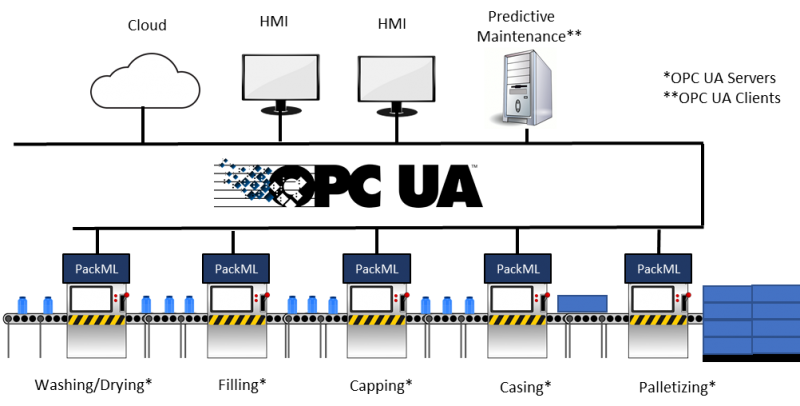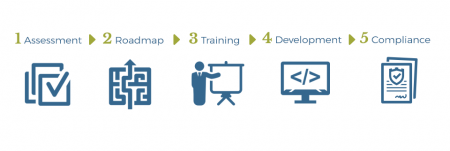OPC UA PackML and MTConnect Companion Specs Drive IIoT Adoption
IIoT is not just a buzzword, but a real phenomenon that is being driven by standards organizations like OPC Foundation, OMAC and AMT. Additionally, Germany has a strategic initiative, known as INDUSTRIE 4.0, that is leading the European Union into the IIoT world so their manufacturing sector can remain globally competitive.
So, why is there such excitement around IIoT and what do the OPC Foundation (opcfoundation.org), Organization for Machine Automation and Control (omac.org), and The Association for Manufacturing Technology (AMTOnline.org) organizations have to do with it?
The OPC Foundation has develop the OPC Unified Architecture (UA) Specification which enables IIoT in the manufacturing environment. UA enables information to be easily shared between sensors, machines, controls, monitoring devices and the cloud in a highly secure, flexible and open way with no custom integration code. The OMAC and AMT organizations, in partnership with the OPC Foundation, have developed the Packaging Machine Language (PackML) and MTConnect version of the UA specification, respectively. It’s the combination of OPC UA with these established industry standards that enables machine tool and packaging machinery systems to be installed and easily interoperate with other systems within the manufacturing enterprise.
Users Spend an Inordinate Amount of Time and Money on Solution Integration and Maintenance
The Manufacturing community (users) has been dissatisfied with the amount of time, expense and complexity required to integrate new systems and extract key metrics from them to monitor and information efficiencies. Each supplier has a different approach, naming convention, communication protocols, metrics and statuses. The complexity grows exponentially as more and more machines are added to the plant. There is very little standardization. This is all changing. The combined efforts of the OPC Foundation, OMAC and AMT have created a standard specification for Packaging and Machine Tool machines, respectively, that when applied makes all machines look and act the same. What the machines do, e.g. washing, filling, capping, labeling, casing and palletizing, are very different, but they are easily integrated to each other, to supervisory systems, and to the Cloud with little effort.
Key Metrics are Standardized in the UA Information Model
Both the OPC UA PackML and the OPC UA MTConnect specifications include standard machine states and maintenance metrics, e.g. uptime, downtime, reason codes, etc. so that all machines look and act the same. And OPC UA allows this information to be automatically accessed in a secure, reliable way automatically. In UA terms, each machine is a Server of information and any system, such as the plant’s Predictive Maintenance (PM) system is Client or consumer of information and is also a Server providing information to supervisory systems like a plant HMI or Cloud solution (see the high-level architecture depicted in Figure 1).
The power of OPC UA is that solutions like PM, when brought online, can automatically Discover the machines that are available in the plant and the machines can automatically serve the PM solution the information they have and if the machines are UA PackML or UA MTConnect enabled the semantics, naming conventions, states, etc. are all the same. The OPC UA PackML specification reduces the integration effort and complexity of machine to machines and the machine to supervisory solution information exchange.
In addition to a simpler, lower cost PM implementation in a single plant, the OPC UA PackML and MTConnect standards enable a standard global view of performance and PM across all plants. Implementing an enterprise, global solution historically entailed very significant implementation, software, and hardware costs. In this enterprise scenario, OPC UA with PackML and MTConnect provide the capture and aggregation of data the plant level and the Cloud easily consumes and presents that data. Adding to the lower cost, some Cloud technologies now provide a PM solution out of the box.

Figure 1 – OPC UA / PackML Enabled Production Line
Best Practice for Adoption of OPC UA, MTConnect and PackML
As manufacturers and technology vendors put their IIoT and automation strategies in place, OPC UA must be a major component of their strategy. Because OPC UA is so comprehensive and all encompassing, moving to IIoT enabled automation means your strategy must address infrastructure, security, co-existence, migration and information model. How to start the adoption process can be overwhelming, but there is a practical, common sense approach to adoption.
The 5-Step IIoT Adoption Process
The 5-Step IIoT Adoption Process (Figure 2) will help both manufactures and technology vendors adopt the OPC UA Specification from concept to certification. The 5-Steps are:
- Assessment: Assessment of the company’s IIoT business, product and automation goals and requirement; the result produces an assessment scorecard that will map current capabilities and goals against the OPC UA specification.
- Roadmap: Defining a plan that addresses migration strategies, a prioritized roadmap of functionality defined in a phased release strategy and recommendations on tooling and training.
- Training: Training of development staff on how to implement the OPC UA specification using appropriate commercial SDKs.
- Development: Development of the information model and software modules needed for compliance, and
- Compliance: Assurance that product releases are compliance with the specification and that OPC UA Logo Certification, if desired, will be successfully achieved.

Figure 2 – The 5-Step IIoT Adoption Process
The Benefits of Adoption
Users and vendors who adopt OPC UA PackML or OPC UA MTConnect will be able to deploy their Predictive Maintenance solution faster and realize:
- Lower integration complexity and cost
- Lower solution maintenance
- Consistent enterprise level view of performance and PM across all plants
The 5-Step Adoption Process will accelerate their move to IIoT using OPC UA so they realize benefits such as:
- Understand the value and the return on investment that OPC UA can bring to your organization
- Do an assessment and develop an IIoT realistic adoption roadmap for your organization
- Experts guidance and a practical, common sense approach will reduce risk, cost and time to market.